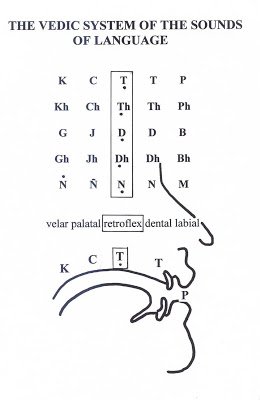The Basic Sounds of Human Mechanism and Cosmos
Here is a simple experiment you can execute - Try uttering all possible sounds without moving your tongue.
Done ?
You will realise a sudden sheer limitation to your vocal creativity.The only sounds you can make by default are AAAA , UUUU and MMMMMM.
All other sounds are simply produced by moving your tongue and positioning them at various places,either consciously or unconsciously.In other words,any sound you make is simply a modification done to the basic trio AAAA , UUUU and MMMM
Reflect this principle upon the universe
Creation initiated from the pranava - AUM which comprises these three basic sounds as well.AUM is the primordial sound of the Universe.
Can you see that you are simply a microuniverse ? The mechanism of your system is a reflection of the Universe.
In Reference to a Pauranik Shloka :
Yat pinde tat brahmande
Your body is a miniature of the cosmos

When Universe speaks a language with tongue movement
As you can speak a language with complex sound-forms rooting from the basic threes with the help of your tongue,the Universe does the same too,just not literally.
Vedas - The Universe Speaks
The Vedas constitute the sounds that reverberate as the cosmos.When there is vibration,there is bound to be a sound.The entire existence is vibrating in different frequencies.In other words,the entire existence is simply an archive of sound energy - with their root as AUM.

These cosmic sounds were heard by Sages of the past who recited them orally generations after generations with its adhering knowledge.This is what we refer to as the Vedas.The famous Gayatri Mantra,Panchaksari Namah Shivaya, Gam are all part of the Vedas.
Now you know why every recitation begins with the pranava AUM / OM ( O is simply a combination of A and U )
Sanskrit being born out of Vedas
The sacred sounds of the Vedas were refined and explored conventionally which gave rise to Sanskrit ( actually pronounced Samskrta ; sam meaning perfected and krta meaning formed )
The Vedas did not come from Sanskrit.It is the other way round.The 'language' of the Vedas has been always referred to as 'Vaidika Bhasha' and not Samskrta.There are many sounds used in the Vedas during recitation that cannot be found in linguistic Sanskrit,validating this fact.
Linguistic Sanskrit enabled us to utilise the cosmic sounds to raise our consciousness even through daily conversations.As time passed,this gave rise to Sanskrit literature as well.
In short,Sanskrit is a replica to the sound structure that reverberates as the cosmos - received originally as the Vedas.
Sanskrit - Anatomically specific

Let's look at the consonants in Sanskrit.They are grouped according to the place of origin within the oral cavity.
The labial sounds,when pronounced,emerge from the vibration of the lips.Whether you say Pa,pha,ba,bha or ma - their root of origin is from the lips ( thus the name 'labial' sounds )
The dental sounds ( ta,tha,da,dha,na) emerge from the teeth,the retroflex sounds ( Ta,Tha,Da,Dha,Na) come from the hard palate ( roof of mouth ) - this is why your teacher might have guided you to position the tongue on the roof of mouth when uttering retroflex consonants,palatal sounds emerge from the soft palate and the velar sounds emerge from the throat.
Try this yourself.Utter the sounds you see in the diagram above and look at where they emerge from within the oral cavity.Look at how scientific the system is !

Vowels of Sanskrit in anatomical specificity
The vowels a and aaa are uttered with mouth half open.These are velar sounds ( produced from throat )
The other vowels can be seen as a modification to AAA through manipulation of the oral cavity.Just try saying AAA and you can complete the other vowels without a pause in between simply by changing the shape of the opening of your mouth.
Vowels i and its extended form iiiii are uttered with the mouth slightly wider.These are palatal sounds ( produced from vibration of palate )
r̥ and r̥r̥r̥r̥r̥r̥ are retroflex in origin.The tongue vibrates slightly on the hard palate.
( r̥ is identified as a vowel in the Vedic system.It is the r̥ used in Kṛṣṇa )
u and uuuuuu are done with the mouth least widely open.They are labial in nature.
E is simply a combination of a and i
O is simply a combination of a and u
We see how the vowels are arranged in a sequence that progress from velar to labial in origin.
Of course,this is an extremely brief view on the wonders of Sanskrit.
Moving to the Vedas - the very origin of Sanskrit,we find even more complex usage of sounds - which cannot be even represented by script.They are learnt by listening to the master recite.
Nevertheless,this short example on how scientifically Sanskrit consonants and vowels are classified is wondrous enough.Of course,the ultimate credits goes back to Veda-mata.
The Parallels :
You ( microcosm ) <------------> Universe ( macrocosm )
Sanskrit <-------------> Vedas
Read more :
(1) Origin of Vedas - The Genesis
(2) Big Bang and Origin of Matter Explained in Rig Veda

Thank you, Teacher
ReplyDeleteThank you my favourite artist
Delete